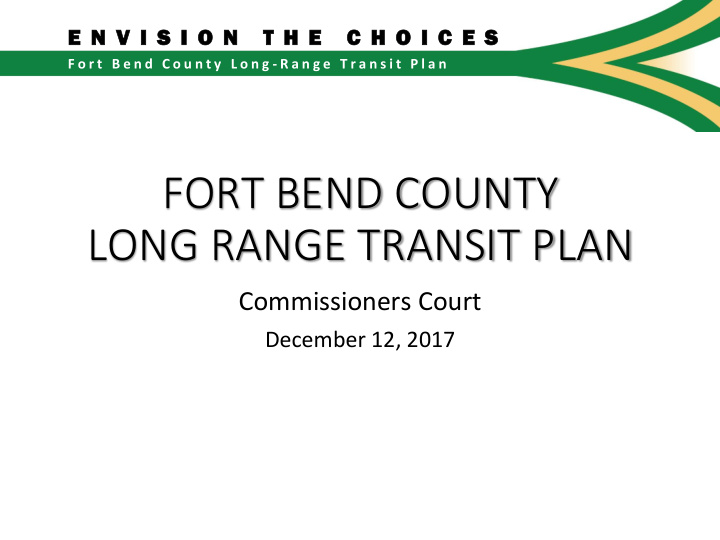



E N V I S I O N T H E C H O I C E S F o r t B e n d C o u n t y L o n g - R a n g e T r a n s i t P l a n FORT BEND COUNTY LONG RANGE TRANSIT PLAN Commissioners Court December 12, 2017
TODAY’S OBJECTIVES • Overarching strategies • Draft project recommendations • Long term vision • Financial plan • Next steps 2
LONG RANGE PLAN STRATEGIES • Communicate and market transit services offered by Fort Bend Transit • Optimize and improve the quality of existing service • Grow and expand opportunity for new service 3
CHALLENGES & OPPORTUNITIES – “COMMUNICATE” • Many county residents are unaware that Fort Bend provides transit services • There is a lack of signage and wayfinding for existing park and ride facilities • Fort Bend Transit website is difficult to navigate for first time users • Route maps and schedules are inconsistently displayed • Branding and messaging on buses are inconsistent 4
CHALLENGES & OPPORTUNITIES – “OPTIMIZE” 160 • Demand response service is over Demand Response Trip capacity Requests Denied per Day • Richmond/Rosenberg service is 1 underperforming Boarding on • There is a lack of passenger amenities at Richmond/Rosenberg Service per Revenue Hour bus stops • Commuter service routes can be overly complicated and time-consuming • METRO and UH Sugar Land currently provide bus services to Harris County 5
CHALLENGES & OPPORTUNITIES – “GROW” • Commuter service ridership on the rise but demand exists for new service to job centers in Harris County. • There is a strong desire for access to major retail destinations in Sugar Land and Missouri City. • Fort Bend is reaching critical mass for higher capacity transit. • Rural areas in the county are currently underserved but also the fastest growing. 6
DEMAND RESPONSE LOCAL FIXED ROUTE COMMUTER SYSTEM-WIDE • Signage & • Signage & wayfinding • New website • Targeted employer • System maps wayfinding • Branding strategy & outreach COMMUNICATE Education campaign • How-to-ride videos/DR program • Scheduling • Service overlap • Scheduling • Fleet strategy • Service overlap • Route design – focus on • Purchasing & – Coordinate demand – Coordinate demand response & fixed travel time maintenance • Reverse commute • Partnership with response & fixed route OPTIMIZE • Route design route opportunities external organizations • Stop amenities • Stop amenities • Coordinate with METRO to reduce redundant service • Expand • New commuter service to • Fleet strategy • Partnership with Rich/Rosenberg Downtown, Energy route to Sugar Land Corridor, Westchase external organizations, • New services along • Permanent P&R locations local entities • Adopt fare policy GROW SH 6 & FM 1092 in in Sugar Land, Missouri City, Fulshear • High capacity transit service: US 59, Westpark, Fort Bend Pkwy/FM 521 7
FORT BEND COUNTY TRANSIT CORRIDORS • Regional High Capacity Transit Corridors & Local Transit Corridors • Phased recommendations • Consistent with other regional planning efforts 9
US 59 CORRIDOR Proposed Services • Short/medium term: New commuter buses to Downtown Houston & Westchase • Long term vision: All-day REPLACE MAP frequent service to all major activity centers • Permanent P&R in Sugar Land Other Considerations • US 59 2-way HOV lanes 10
WESTPARK CORRIDOR Proposed Services • Short/medium term: New commuter buses Energy Corridor, Westchase, Uptown & Greenway Plaza • Long term vision: All- day frequent service to all major activity centers • New P&R in Fulshear Other Considerations • METRO Westpark ROW • Lack of direct connector ramps to US 59 HOV 11
FORT BEND PKWY/FM 521 CORRIDOR Proposed Services • Long term vision: Commuter bus service to TMC & Downtown • Permanent P&R south of Missouri City Other Considerations • Fort Bend Pkwy Extension to Grand Pkwy • Travel times on FM 521 12
RICHMOND/ROSENBERG SERVICE Proposed Services • Short term: Redesign to operate on a pulse basis at a single transfer point • Medium term: New route to Sugar Land Town Square Other Considerations • Challenges in implementing point deviation service to Sugar Land 13
EXISTING VS.PROPOSED RICHMOND/ROSENBERG ROUTES EXISTING PROPOSED 14
SH 6 and FM 1092 Transit Opportunities and Challenges SH 6 FM 1092 • Highly developed commercial • Bookended by two major corridor destinations • Connections to all major east-west • High population density regional highways • Large industrial developments • High speed roadway with up to 9 • Major destinations located along travel lanes at major intersections side streets • Most destinations feature large setbacks from the road Further study is recommended to identify appropriate transit strategies in these corridors 15
FINANCIAL ANALYSIS • Purpose of analysis: • To understand FBCT’s financial capacity for the continuation of current services and for implementing new services • Analysis based on: • FBCT’s last four years of revenue and expenditures (2014 – 2017) • Historical County budget data (1996-2016) • Trends in federal funding for transit 16
Federal Funding Challenge 18
Scenario Results 19
Scenario Results 20
Financial Plan • Scenario 2 used to develop revenue and expenditure forecast (2018-2040) • Plan is constrained for first five years with a county contribution of $2M/annually • County contribution covers shortfall in operating revenue • Includes short-term program of projects • After 2023, plan does not include specific projects 21
Summary • Final draft document contains short-term and long- term recommendations • Improve marketing strategies • Revise Richmond/Rosenberg service • Initiate Westchase service • Initiate Downtown service • Continue to pursue capital funding opportunities • Work with federal, state and local partners to find solutions for increased operating revenue 22
Recommend
More recommend